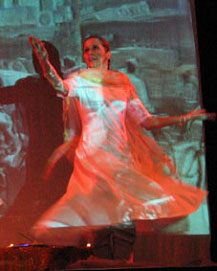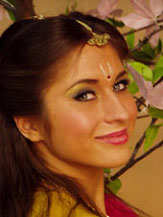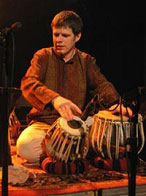DAMARU
Ivana and Anežka Hessová - kathak dance
Elena Kubičková - esraj
Tomáš Reindl - tabla, dijeridu, vocal part, real time looping
The Damaru group draws from the tradition of kathak: a north Indian temple dance,
but dapproaches it in a its characteristic, creative manner. Experts consider kathak to be
the only Indian classical dance in which even the Indian artists can create new
choreography. Damaru combines the world of dance and music in a one hour long
performance. The traditional forms are supplemented by improvised parts, which
originate from the group's European background experience. Damaru's expression is
based upon the ancient principles of classical north Indian ragas, however, some parts of the musical
component of the performance are enriched with several other instruments and colours (including dijeridoo
and overtone singing) as well as modern sampling technology.
The suggestive dance scenes are further amended by projections of photographs and
of a video documentary on white saris and on the dancers' bodies. The photographs by
Viliam Poltikovič, an excellent documentarist, and by Dani Schwalbe, a German
photographer, feature mainly Indian women. The video documentary from the group's
journey to India is interesting not only in terms of stage design or the documentary
aspect, but it also supports and provokes the meaning of various scenes.
The group performed: music, theatre and film festivals (Karlovy Vary 2002/09,
Příjemná setkání 2003, Ferrara International Festival - Italy 2004,
Indian Food Festival 2005, Alternativa and Etno Brno 2005/06,
One World Film Festival 2006, Happy fest 2007/09, Febiofest 2003/04/06/08,
the Forman Bro.'s Festival 2003,06/07/08/09/10, etc.),
the group supported Day for India 2002 (UNICEF), Dance for Asia 2005,
Diwali Festivals 2005/06/07/08/09, in Prague
accompanied the performances of excellent Indian artists (kathak dancers and
musicians): Dr. N. Jafa (kathak) 2002, Dr. J. N. Goswami (sitar) and M. S. Tripathi (tabla) 2005,
S. Mallick (kathak) 2005/06/07/08/09/10.
Excellent musicians (Amit Chatterjee, Shahab Tolouie, Avijit Goswami) as well as
dancers (S. Mallick, Rasa Bihári) are being invited to join new projects of the group.
Damaru also cooperates with the Embassy of India in artistic projects.
 Ivana Hessová
Ivana Hessová
She graduated from the Theatre Academy of Arts. With the Tujú theatre,
she performed both in Czechoslovakia and abroad (Mexico, New York, Denmark, Austria,
Poland etc.) In 1992 Ivana Hessová started to work for the
Montreurs D'Images Theatre in Switzerland.
There, under the guidance of French professor N. Rapallie, she started to study kathak.
In 1992 in Geneva, she became disciple of the Indian kathak master Mata Prasad Mishra. In 1997 she undertook
a study trip to India, Varánásí, to take lessons from guru M. P. Mishra.
The following year, she performed as actress and dancer in
Draupadí, a highly challenging production focussed on the vedic myth Mahabharata. In February
2001, on completing her courses in India at guru N. Rajendra in Bangalore
(Lucknow Gharana) and at guru M. P. Mishra in Varánásí (Baranas Gharana) she
founded the Damaru group. In July 2001, she launched a performance
entitled "Indian Inspiration" (Taneční listy, volume 39, September 2002), where
she worked as stage director and dancer; in May 2005, she launched a dance
documentary dedicated to the Indian politician Phoolan Devi "For Phoolan..." (Respekt 18/05, A2 10/05, Právo 12/05),
in November 2007, she combined kathak dance with Gypsy dances in a performance called "Gypsy Suite".
Since 1995, she has been teaching Indian kathak dance in Prague, organising workshops and
dance performances with excellent kathak dancers from India M. P. Mishra (1998)
and S. Mallick (2005/06/07/08). In 2006 and 2008 she travelled to Kalkutta to study kathak at S. Mallick's "Nataraj"
dance school (Lucknow gharana).
Since 1997, she has also been organising Summer Encounters in
Mnichovo Hradiště, where she has been working as dance tutor. As an external lecturer she
participates in "Collegium Ethnomusicologicum", a Certified Programme of Ethnomusicology
at the Faculty of Humanities (Charles University, Prague).
 Anežka Hessová
Anežka Hessová
In 1991, she accompanied her mother to Switzerland, there she studied French at
a private Waldorf school and contemporary dance under the guidance of prof. M. Decosterd.
She also took part in many theatre projects of
Theatre Montreurs d'Images.
In 1998, she took up the study of Kathak Indian dance as a disciple of guru M.
P. Mishra; she continued her training in Prague. In 2001, she travelled to
India to improve her kathak dance skills in Bangalore and in Benares in the
classes of guru N. Rajendra and M. P. Mishra and in 2006 to Kalkutta (S. Mallick).
As dancer she participated in the "Indian Inspiration", "For Phoolan..." and "Gypsy Suite" performances.
She also co-operated with various theatre groups: NUN, BDS and ANPU. In 2008/09, she received a one-year scholarship from
ICCR (Indian Council for Cultural Relation) to study kathak at the "Dhwani" dance school
in New Delhi as a disciple of the excellent dancer Vaswati Mishra.
 Elena Kubičková
Elena Kubičková
http://esraj.taxasoft.cz
E. Kubičková studied classical violin under the guidance of Prof. G. Morenová
at the Prague Conservatory. For several years, she performed with the chamber
string orchestra. She was educated in Indian music by violinist and musicologist
Prof. Dr. Smarajit Chakravorty; in Varanasi, India, she studied at Dr. V. Balaji -
singer and violinist, professor of Banaras Hindu University and at the sitar
player Jibendra Narayana Goswamí (1st in the all-Indian "Sangeet Academy Competition" in 1995).
She has been playing the esraj since 1990. Together with other
musicians she released several CDs. Some of them were used as film music, eg. in Igor Chaun`s
film trilogy "Cesta do Indie" (Journey to India).
She performed at various festivals (Boskovice,
Frýdek Místek, A Week for Broumovsko, Alternativa (Theatre Archa), Vysočina Music Festival, Febiofest,
One World, Pragur Musical Evenings in the Spanish Synagogue, forman Bro's Mystery Boat, Sázavafest
etc., she also performed in Poland and in Italy (2004, Ferrara International Festival,
together with Damaru).
She plays Indian classical music with
tabla players Tomáš Reindl and Fabrice Michel, Canadian sitar and oriental instrument player Edward Powell.
Her experimental duets with violinist Lukáš Kuta confront European classical music with the Indian one.
Her performances with the Indian sitar player Dr. J. N. Goswami and his accompanying Indian tabla player
are worth noting, they even performed at the Smetana's Litomyšl International opera festival.
She regularly gives concerts of north Indian ragas and lectures on Indian music (HAMU, JAMU).
Since 2002, she has been participating in the joint
music-and-dance project DAMARU based on the classical Indian kathak dance, Indian ragas and other
musical and scene elements. The CD of Indian ragas which she recorded together with T. Reindl was awarded the
highest possible score by the Harmony magazine.
For several years, she has been preparing regular night programs
of Indian classical music on the Czech Radio station Vltava. She writes for music magazines.
 Tomáš Reindl
Tomáš Reindl
http://www.tabla-tom.com/
Tomáš Reindl is a musician with a very wide field of activity. He also composes and records his own music.
He specializes in percussions and drums, Indian tabla, Arabian and African drums, Australian didjeridoo
and other instruments. He studied percussion at the Pilsen conservatory from Prof. Kympl and from the jazz
percussionist I. Audes. He travelled twice to India to study tabla playing, he keeps on taking lectures from
the tabla virtuoso Sanju Sahai, who lives in London. The encounters with the excellent players Benjamin Olgucane (Istambul),
Pete Lockett (multi-percussionist, well known for collaboration with Pete Gabriel) or Yinon Muallem (Israel)
were a great asset. In the past he collaborated with: Šum Svistu, Feng-Jün Song, Milan Svoboda, Iva Bitová, Musica Florea,
Al-Yaman, The Wings, Jaroslav Svěcený and others. He accompanied Indian artists such as: Jibendra Narayan Gosvámí,
Sandip Mallick, Ghulam Murtuza Khan, Amit Chatterjee. Today: own project called DIDYMOS, collaboration
with the excellent musician of Indian origins Amit Chatterjee (known for accompanying Joe Zawinul), other projects:
Radek Krampl Trio, Jana Koubková, DAMARU Indian dance group, Tellemarkk duet, he plays Indian classical music with
E. Kubičková (esraj) and Edward Powell (sitar). He also composes stage music and works as a tutor of various rhythm workshops and courses.
Indian Classical Music
There are two elementary systems of Indian classical music - north Indian, also
called Hindustani, and south Indian, called Carnatic. The vocal and instrumental
north Indian classical music is based on ragas and talas. Melodic structure, rules
for using micro tones and ornaments are determined by raga
(there are several hundred of known ragas), rhythmic cycles are set by tala.
Esraj is a traditional Indian string instrument. It has 19 strings
out of which consisting of 4 main strings. The rest is formed into two octaves
of resonant strings tuned into given gamut.
Tabla is a set of two drums. The drum on the right side is called dayan
and is tuned in the key tonic. The left-side drum is called bayan and is
tuned into bass. Tabla in India is a traditional accompanying instrument for kathak dance.
Indian Classical Dance
Brief History:
Indian classical dance was originally performed in temples as an evocation and thank
offering to gods. However, during the rule of Mughal Dynasty the dance in the temples
was forbidden and moved to the palaces of the Rajas. The literary content was
suppressed in favour of mastering pure technique. Nevertheless, Hindi myths and legends
were preserved in the narrative parts. Traditional dance is performed by one dancer, who is more of a story teller. Present day kathak is an elaborate art. It has undergone important changes in its forms and expressions. The dancers themselves contributed greatly to its development with their own modern artistic choreography.
Technique:
The technique of kathak is based primarily on the choreography speech,
demonstrated by mudras (hand gestures), rhythmic motions of legs, facial
expressions and figurative body positions. The legs move in accordance to a set
of complex rhythmic patterns. In addition, there are small ankle-bells (ghungaru)
attached to both legs of the dancer. Their sound, when the feet hit the floor,
is admiringly synchronised with gesture positions of the upper part of the body.
Strong emphasis is put especially on pirouettes and jumps accompanied by the
beat of drums called tabla. The teacher leads the disciple to virtuosity in
all syntactic parts of the dance.
Contents:
Apart from the elements of pure technique, kathak still preserves its capacity
to retell the myths and legends of ancient India. Body positions and gestures
represent Hindi gods and legendary figures. In its narrative part, the dance
interprets human emotions and thus can become a basis for scenic poetic expression.
Space requirements: minimum 4 x 5 metres
Full sound requirements:
6x mic (out of which condenser mic), 4x line (big jack),
receptacle 220V (3x), at least 2x monitor
Lights: 4 - 6 headlamps, diascope and video projector (according to contract)
Other: floor without carpets, possibility to hang up 3 saris (curtains) at 3m
Stage plan can be downloaded here.
In smaller spaces technical conditions may be altered after a mutual agreement.
Contact:
MgA. Ivana Hessová, U družstva Život 23, Praha 4 - Nusle 140 00
Tel. +420 241 412 417, +420 606 952 175
Email:ivanahessova9@gmail.com
Ing. Tomáš Reindl, Chrustenice 218, 267 12 Loděnice
Tel.: (+420) 603 811 672
E-mail: tomasreindl@tiscali.cz,
tabla-tom@tabla-tom.com,
www.tabla-tom.com,
www.myspace.com/tomasreindl
Elena Kubičková, Krocínova 5, Praha l - Staré Město 110 00
Tel.: (+420) 242 38 618, (+420) 776 165 615
E-mail: ekubickova@centrum.cz
http://esraj.tasoft.cz